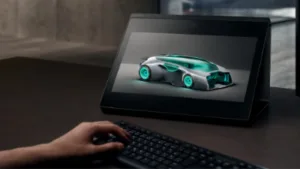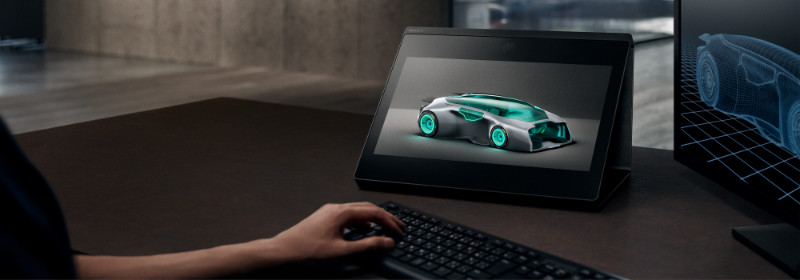Last Friday, Sony announced a new Ultra HD autostereo display. It’s called The Spatial Reality Display (SRD), employs a proprietary eye-tracking system (Eye-Sensing Light Field Display) that was first demonstrated at CES 2020, and looks to be a clever product – if a bit on the small size for everyday work.

The SRD uses a 15.6-inch LCD panel with 3840×2160 pixel resolution, but Sony won’t say where it’s sourced or what type of panel it is. Given the company’s long-time adherence to IPS alignment and its variants, I’d say that’s a good guess – particularly for an autostereo display where off-axis viewing in the horizontal plane is important.
According to the news release, a micro lens array sits atop the LCD panel to provide the requisite parallax barrier. Sony’s eye-tracking system then dynamically splits the image into two full HD (1920×1080) views, tracking eye movement in 3 axes using “…an innovative high-speed vision sensor which follows exact eye position in space.” (I’m not sure how such a sensor can measure a change depth axes, unless the viewer’s head is moving toward or away the screen.)
Other details are sketchy. Sony’s PR rep would only confirm that the display can reproduce the Adobe RGB color space, but I couldn’t find out anything about the backlight design, whether the display can handle HDR images and high frame rates, and what version of the HDMI interface is employed. Sony does state that a real-time processing algorithm is used to ensure smooth presentation of images as the viewing angle changes.
A Bit More
Here are some additional specs. The eye-tracking system can operate with viewing angles +20 degrees and -40 degrees vertically and ± 25 degrees horizontally, and has a usable viewing distance range of 12 to 29 inches (30cm – 74cm). The panel has a rated brightness of 500 cd/m² and a claimed contrast ratio of 1400:1. With a rated power consumption of 24 watts, it’s likely using a conventional LED backlight array. The suggested retail price is $4,999 and it will start shipping next month.
According to the release, Sony “…recommends use of “high resolution, quality images” created using Unity or Unreal Engine 4 software” and they suggest driving the SRD with “…a recommended CPU of Intel Core i7-9700K @3.60GHz or faster; and a graphics card such as NVIDIA GeForce RTX 2070 SUPER or faster.”
This display contrasts with the 8K autostereo models shown by Dimenco (also eye tracking) and Looking Glass (basic autostereo) in panel size. 15 inches seems a bit on the small size to me, particularly since I can double that with the Dimenco 8K 32-inch offering and have 4K resolution per eye, although at 4x the cost. Like Dimenco, the SRD is designed for a single viewer, unlike the Looking Glass 8K 31.5-inch autostereo display, which provides multiple views simultaneously.
Dimenco even went to the trouble of posting a “Welcome!” notice on its Web site, acknowledging Sony’s introduction of the SRD by paying them somewhat of a backhanded, snarky compliment. To wit:
“SR – Simulated Reality is strengthened by those that believe spatial technology is the future. We hope the purchase of our SR Development Kits inspired you to take this visionary step. Based upon our 10 years of experience in developing Simulated Reality technology, we are glad to see your adaptation and recognition of the future of spatial computing without wearables. We know others will follow.”
So, apparently Sony bought Dimenco’s SR Development Kit, and that’s what inspired them to come out with their own home-cooked product? Sounds like it. In any case, it’s good to see more companies getting into the autostereo game, although I’m surprised Sony didn’t aim higher with a larger screen and higher pixel resolution. 15 inches is mostly a field production monitor size now.
You can see videos of the display in action at https://youtu.be/KrLMnQM0_Ps . -PP
Editor’s Comment
I got to see the demo at Sony’s booth at CES and the performance was very good, although it was described, if I remember correctly as a light field displays, which is not how I would characterise it. By tracking the eyes of the user and re-rendering the image in real time and very smoothly, it really gives a good impression of looking around an object. (BR)


